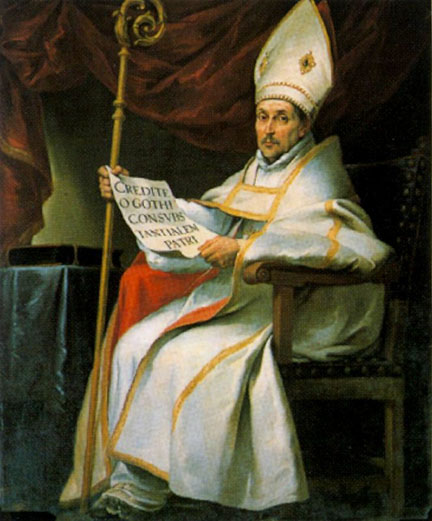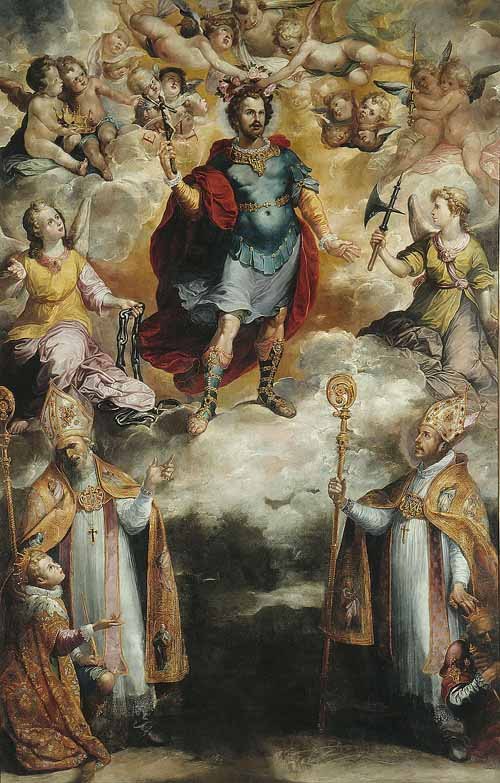 Champions of Catholic Orthodoxy
Champions of Catholic Orthodoxy Champions of Catholic Orthodoxy
Champions of Catholic OrthodoxySt. Leander was of an illustrious family, and born at Carthagena in Spain. He had two brothers, St. Fulgentius, Bishop of Ecija and Carthagena, and St. Isidore, our Saint’s suc-cessor in the See of Seville. He had also one sister, Florentia by name, who had consecrated herself to God in the state of virginity. He set them an example of heroic piety which they faithfully imitated. He entered into a monastery very young, where he lived many years, and attained to an eminent degree of virtue and sacred learning. These qualities occasioned his being promoted to the See of Seville: but his change of condition made little or no alteration in his method of life, though it brought on him a great increase of care and solicitude for the salvation of those whom God had put under his care, as well as for the necessities of the whole church, that of Spain in particular. This kingdom was then possessed by the Visigoths, or Western-Goths. While Theodoric settled the Ostrogoths, or Eastern-Goths, in Italy, the Visigoths had passed the Alps, and founded their kingdom, first in Languedoc, and soon after, about the year 470, in Spain. These Goths, being for the generality all infected with Arianism, established this heresy wherever they came; so that when St. Leander was made Bishop, it had reigned in Spain a hundred years. This was his great affliction: however, by his tears and prayers to God, and by his most zealous and unwearied endeavors both at home and abroad, he became the happy instrument of the conversion of that nation to the Catholic Faith. But he suffered much from King Leovigild on this account, and was at length forced into banishment; the Saint having converted, among others, Hermenegild, the King's eldest son and heir apparent.
This pious prince was put to death by his unnatural father the year following, for refusing to receive communion from the hands of an Arian bishop. But, touched with remorse not long after, the king recalled our Saint, and falling sick and finding himself past hopes of recovery, he sent for St. Leander, whom he had so much persecuted, and recommended to him his son Recared, whom he left his successor, to be instructed in the true Faith; though out of fear of his people, as St. Gregory laments, he dared not embrace it himself. His son Recared, by listening to St. Leander, soon became a Catholic. This new King also spoke with so much wisdom on the controverted points to the Arian bishops, that by the force of his reasoning, rather than by his authority, he brought them over to admit the truth of the Catholic doctrine; and thus he converted the whole nation of the Visigoths. He was no less successful in these pious endeavors with respect to the Suevi, a people of Spain, whom his father Leovigild had perverted. It was a subject of great joy to the whole Church to behold the wonderful blessing bestowed by Almighty God on the labors of our Saint, but to none more than St. Gregory the Great, who wrote to St. Leander to congratulate him on the subject. (See image below where St. Hermenegild is pictured in glory, with Ss. Leander and Isidore. The young King Recared is pictured at bottom left; the old King Leovigild at bottom right.)
 This holy prelate was no less zealous in the reformation of morals, than in restoring the purity of Faith; and he planted the seeds of that zeal and fervor which afterwards produced so many martyrs and saints. His zeal in this regard appeared in the good regulations set on foot with this intent in the council of Seville, which was called by him, and of which he was, as it were, the soul. In 589, he assisted at the Third Council of Toledo, of seventy-two bishops, or their deputies, in which were drawn up twenty-three canons relating to discipline, to repair the breaches the Arian heresy had made in fomenting disorders of several kinds. One of these was, that the Arian clergy cohabited with their wives; but the council forbade such of them as were converted to do so, enjoining them a separation from the same chamber, and, if possible, from the same house. Thus we see how great was the esteem for clerical celibacy, even at this relatively early date.
This holy prelate was no less zealous in the reformation of morals, than in restoring the purity of Faith; and he planted the seeds of that zeal and fervor which afterwards produced so many martyrs and saints. His zeal in this regard appeared in the good regulations set on foot with this intent in the council of Seville, which was called by him, and of which he was, as it were, the soul. In 589, he assisted at the Third Council of Toledo, of seventy-two bishops, or their deputies, in which were drawn up twenty-three canons relating to discipline, to repair the breaches the Arian heresy had made in fomenting disorders of several kinds. One of these was, that the Arian clergy cohabited with their wives; but the council forbade such of them as were converted to do so, enjoining them a separation from the same chamber, and, if possible, from the same house. Thus we see how great was the esteem for clerical celibacy, even at this relatively early date.
St. Leander, sensible of the importance of prayer, which is in a devout life what a spring is in a watch, or the main wheel in an engine, labored particularly to encourage true devotion in all persons, but particularly those of the monastic profession, of which state it is the very essence and constituent. His letter to his sister Florentina, who as a nun, directed forty convents and over a thousand religious sisters, is called his Rule of a Monastic Life. It turns chiefly on the contempt of the world, and on the exercises of prayer. This Saint also reformed the Spanish liturgy. (While northern Spain first received the Faith from the Apostle St. James the Greater, the church of southern Spain had received it from Rome, as Pope Innocent I informs us in Ep. ad Decent. Whence St. Isidore says their divine office was instituted by St. Peter [l. 1. c. 15. Eccl. Offic.] Their ceremonies and discipline, such as fasting on Saturdays, and other rites mentioned in their council, are Roman. And the Roman liturgy was used in Africa, beyond Spain. But the Goths used a liturgy formed by Uphilas from the Orientals. St. Leander is said to have compiled a liturgy from both, and also from the Gaulish and Oriental liturgies: St. Isidore and St. Ildephonsus perfected it. When the Saracens or Arabians became masters of Spain, the Christians of that country were called Mixt-Arabs, and their liturgy, Mozarabic. In the eleventh and twelfth centuries this liturgy gave place to the Roman.) In this liturgy, and in the Third Council of Toledo, in conformity to the eastern churches, the Nicene creed was appointed to be read at Mass to express a detestation of the Arian heresy. Other western churches, with the Roman, soon imitated this devotion. We may say, then, that we owe it to St. Leander that the Nicene Creed is such an important element in the Roman Missal.
St. Leander was visited by frequent ailments, particularly the gout, which St. Gregory, who was often afflicted with the same, writing to him, calls a favor and mercy of Heaven. This holy doctor of Spain died between the year 596 and 601, on the 27th of February, as Mabillon proves from his epitaph. The church of Seville has been a metropolitan See ever since the third century. The Cathedral is the most magnificent, both as to structure and ornament, of any in all Spain. Although his brother, St. Isidore, is more widely known (he is a Doctor of the Church and his feast is on the Universal Calendar), nonetheless it is St. Leander who is considered by Spain to be its savior from the Arian heresy.
The contempt of the world which the Gospel so strongly inculcates, and which St. Leander so eminently practiced and taught, is the foundation of a spiritual life; but is of far greater extent than most Christians conceive, for it requires no less than a total disengagement of the affections from earthly things. Those whom God raises to perfect virtue, and closely unites to himself, must cut off and put away everything that can be an obstacle to this perfect union. Their will must be thoroughly purified from all dross of inordinate affections before it can be perfectly absorbed in His. Those who are particularly devoted to the divine service, are especially to take notice of this. If this truth were imprinted in the manner that it ought, in the hearts of those who enroll themselves in the service of the Church, or who live in cloisters, they would be replenished with heavenly blessings, and the Church would have the comfort of seeing apostles of nations revive amongst her clergy, and the monasteries again filled with the imitators of St. Antony, St. Benedict, St. Leander and St. Bernard; whose sanctity, prayers, and example would even infuse into many others the true spirit of Christ amidst the desolation and general blindness of this unhappy age.
Contact us: smr@salvemariaregina.info
Visit also: www.marienfried.com